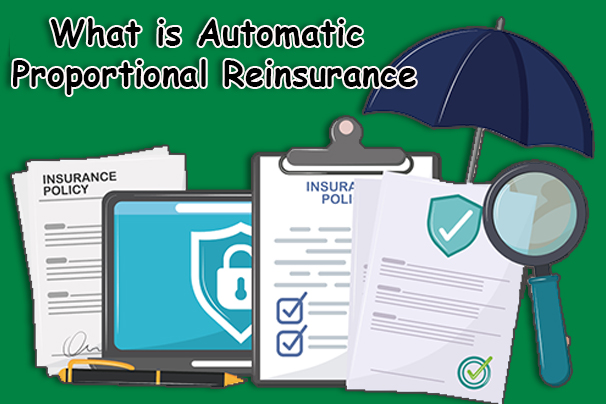Automatic proportional is a type of reinsurance that is found on the splitting of premiums, expenses, and losses between the primary insurer and the reinsurer according to a certain predetermined segment. This reinsurance serves as a backup risk management option for most insurance companies. If ever they accumulate or assume too much risk, they can purchase this type of reinsurance. This reinsurance stands as an alternative to non-proportional reinsurance. Non-proportional reinsurance does not split risk and gains more on a predetermined proportion.

It offers a more flexible way for insurance companies to overcome risks instead of bearing losses alone. Automatic proportional reinsurance helps insurance companies manage risk exposure and helps improve their financial stability. Automatic proportional reinsurance is the best choice for insurance companies because of its benefits and how well it helps make risk management easier. The write-up contains all the information you need about this reinsurance type.
How Does Automatic Proportional Reinsurance Work?
Automatic proportional reinsurance is an agreement involving a ceding commission; this means a fee is paid by the reinsurer to an insurance company for accumulating a portion of their risk. The ceding commission is mostly a percentage of the premiums paid by a policyholder of an insurance company. In exchange for the ceding commission paid by the insurance company, the reinsurer accumulates a fixed percentage of the losses and premiums of the insurance company.
Types of Automatic Proportional Reinsurance
As previously stated, automatic proportional reinsurance is a type of reinsurance where risks and premiums are split between the insurance company and the reinsurer in a predetermined proportion. There are different types of automatic proportional reinsurance insurance companies can select from. The types of this reinsurance include
Quota Share Reinsurance
This is a type of proportional reinsurance where the reinsurer agrees to share a fixed percentage of every policy with an insurance company. It is useful for small to medium-sized insurance companies that intend to reduce their risks and elevate their capacity.
Surplus Reinsurance
Surplus reinsurance is another type where the reinsurer agrees to share a percentage of the policy amount above a particular limit with an insurance company. This limit is known as the retention limit. This type of reinsurance is best for large insurance companies that intend to shield themselves from disastrous losses.
Stop-loss Reinsurance
This type of proportional reinsurance is where the reinsurer agrees to pay an agreed amount for every claim above a particular amount called the attachment point. This type of reinsurance is a good option for insurance companies that intend to protect themselves from large losses.
Excess of Loss Reinsurance
This is yet another type where the reinsurer agrees to pay a fixed amount of money for every claim above the retention limit. Insurance companies that want to shield themselves against disastrous losses.
Each type of automatic proportional reinsurance has its advantages and disadvantages. Depending on the needs of the insurance company, they can easily determine which of these types are best for them.
Automatic Proportional Reinsurance Benefits
This reinsurance has different benefits that make it a good option for insurance companies. These benefits include:
Risk Management
Automatic proportional reinsurance allows insurance companies to split risk exposure with a reinsurance company. This process helps them manage their risk exposure and reduce volatility. Through this process, insurance companies can maintain their financial stability and avoid insolvency in the event of a disastrous loss.
Capital Management
With this benefit, insurance companies can manage their capital by leasing their required reserves and creating capital for investments.
Enhanced Underwriting
This reinsurance offers insurance companies the access they need to additional underwriting competence and resources, letting them better access and price risks.
Automatic proportional reinsurance offers a variety of benefits to both reinsurers and insurance companies. Due to these benefits, insurance companies choose this coverage to help manage risks.
Factors to Consider When Choosing Automatic Proportional Reinsurance
Proportional reinsurance is an essential tool used by insurance companies to manage risks. Before selecting the type of proportional reinsurance for you, you need to consider the following factors.
Type of Proportional Reinsurance
Between the types of automatic reinsurance, you need to consider which fits your needs. You need to consider the risk you want to transfer and how much the transfer you are making costs.
Risk Capacity
Your risk capacity will determine the amount of risk you will be transferring to the reinsurer. If you have a high-risk capacity, you may go for a higher percentage, while insurance companies with lower risks can go for a lower percentage of automatic proportional reinsurance.
Reinsurer financial strength
Check out the financial strength of the reinsurer when considering automatic proportional reinsurance. You need to confirm if the reinsurer can pay claims in case of any disastrous loss.
Premium and Commission
The premium and commission charged by the reinsurer are key factors to consider when selecting the right proportional reinsurance for you. Ensure that the premium and commission charged are reasonable and competitive. You can also decide to compare the premium and commission with those of different reinsurers to help you find the best for you.
Claims Handling
Another key factor to consider when choosing proportional reinsurance is claim handling. You need to make sure the reinsurer has a good record in claim handling. This may be done by checking out their claim process and the time they take to settle claims. Selecting the right automatic proportional reinsurance program requires you to carefully consider different factors.





